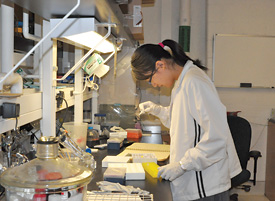In the summer of 2007, LSA launched a pilot program with China’s Peking University to provide summer research opportunities for students at both universities in the chemical sciences. Over the years the program expanded to include Tsinghua University as well as the biological and life sciences. It has provided research opportunities for 70 students from U-M and 86 from China.
One of few such bilateral exchange programs in the United States, the U.S./China Summer Undergraduate Research Exchange Program offers students eight to 10 weeks of research opportunities in a laboratory, as well as cultural experiences in their host country. Support for the program, totaling $1.1 million, has been provided by LSA, the U.S. National Science Foundation, the two Chinese universities, Pfizer Global R&D, and private donors, including U-M alumnus Rich Rogel.

Tian Qiu, a student at Peking University, works on research in the laboratory of Carol Fierke, chair of the LSA’s Chemistry Department, during the summer 2010 exchange program. Photo by Beverly Lange.
This summer, for the first time, the Chinese National Science Foundation (NSF-C) has agreed to fund the cost of six students from Peking University, who will do research in LSA’s Department of Chemistry. Tsinghua University will fund the cost of six additional students in the biological and life sciences. The students are scheduled to arrive June 25.
The decision by the NSF-C is an indication of the international significance of the program, says James Penner-Hahn, LSA associate dean for budget and the George A. Lindsay Collegiate Professor of Chemistry and Biophysics. It also demonstrates how U-M has influenced China’s willingness to expand funding for undergraduate research.
“LSA funded the pilot exchange program because we believed that a bilateral program was a great opportunity both for the students who went to China and for the students who did research in Ann Arbor during the summer,” says Penner-Hahn, who helped start the pilot program. “The decision by the Chinese NSF to choose our program as the first undergraduate exchange program that they have supported validates this decision.”
The NSF-C’s decision comes, ironically, at a time when the budget crisis in Washington, D.C., has forced the U.S. National Science Foundation to cut funding for U-M chemistry students, says Brian Coppola, Arthur F. Thurnau Professor, professor of chemistry and one of the program’s directors. Because of the cutbacks no U-M students will study in China through this program this summer. The program has applied for NSF funding for biology students and is exploring other funding sources.
“The cuts from the U.S. NSF chemistry division are discouraging but they are a sign of the times,” Coppola says. “The positive effects on U-M students who participate in this program are fantastic, and we are committed to finding ways for it to continue.”

